July 2021 Develop PGH Bulletins: Pitt brings case for Oakland building’s demolition to commission – PublicSource
 Develop PGH Bulletins updates you on the Pittsburgh region’s economy. Check back frequently, sign up for the Develop PGH newsletter and email [email protected] with questions, tips or story ideas.
Develop PGH Bulletins updates you on the Pittsburgh region’s economy. Check back frequently, sign up for the Develop PGH newsletter and email [email protected] with questions, tips or story ideas.
7/27/21: Facade of former Croatian Federal Union building could be preserved, reused
The University of Pittsburgh’s plans to tear down a longstanding Forbes Avenue building drew no objections from the City Planning Commission at an initial briefing ahead of a hearing and likely September vote.
Pitt wants to demolish the former Croatian Federal Union of America building, at 3441 Forbes Avenue. From 1963 on, the building served as the Allegheny County Health Department’s headquarters. The county sold it to Pitt in 2018, for $1.9 million. The building isn’t in a historic district, so only the Planning Commission – and not the Historic Review Commission – needs to approve demolition.
Cracks in the building are worsening with ongoing freeze-thaw cycles, said Mary Beth McGrew, Pitt’s associate vice chancellor for planning, design and real estate. She said there’s “a bit of danger in the roof collapsing.”
Maintaining the facade while demolishing and rebuilding behind it would have been very difficult, because of the basement beneath it and the “fragility” of the clay, said McGrew.
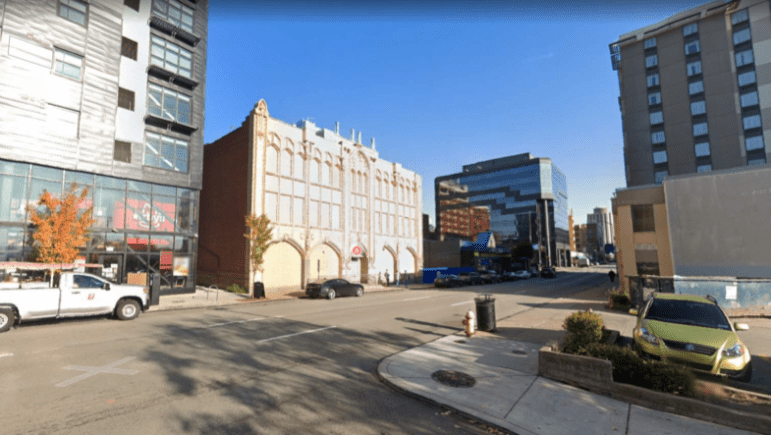
The former Croatian Federal Union of America building at 3441 Forbes Ave., in an image provided to the City Planning Commission on July 27, 2021. The University of Pittsburgh seeks to demolish it, but then to rebuild the historic facade.
Nonetheless, recognizing the significance of the facade, Pitt worked with Preservation Pittsburgh on a plan that involves dismantling the clay tile front, storing it, and eventually reusing it, though perhaps not as the front of a replacement building. The old facade could conceivably stand on the side of a new building, according to one potential concept presented to the commission.
Pitt has not decided what it will ultimately do with the site, Dusty Elias Kirk, their attorney on this matter, told the commission. “We obviously will be back before you before we can construct anything else,” she said.
In the meantime, if the commission approves of the demolition, the basement will be filled with gravel and the site fenced off, according to McGrew.
Commission Chair Christine Mondor said she appreciated that Pitt was planning on “honoring the character and the history of that building.”
The commission’s public hearing and vote on the proposal could occur on Sept. 14.
In other Oakland matters, the commission approved the demolition of 12 dilapidated row houses along Bates Street and Coltart Avenue. Pitt plans to buy them but hasn’t said what it will do with the site.
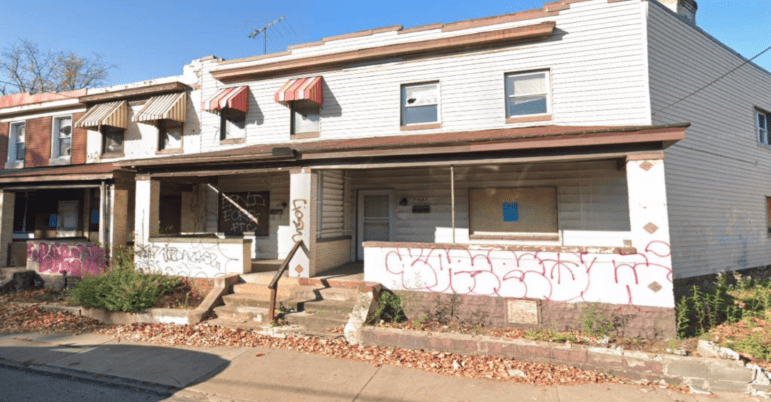
Some of the row houses along Bates Street, in a photo presented to the City Planning Commission by representatives of developer Walnut Capital in preparation for a hearing on July 27, 2021.
And the commission gave its OK to Carnegie Mellon University’s plan to demolish part of Skibo Hall, excluding the gymnasium, and redevelopment as a new center for CMU’s health, wellness, counseling, psychiatric and athletic offices and facilities. Skibo Hall was designed by renowned early 20th Century architect Henry Hornbostel, but lacks modern amenities like elevators and air conditioning, CMU’s representatives told the commission.
7/27/21: Discussion of Strip apartments gets heated before approval
A reluctant City Planning Commission approved plans to build an eight-story, 243-unit residential building near the Strip District end of the 31st Street Bridge.
The approval came after a sharp exchange between Commissioner Rachel O’Neill and attorney Robert Lampl, who represented developer Westrise Capital at the commission’s public hearing on the Crucible Lofts proposal.
Architect Karl Smeltzer said he aimed for a design that fuses the industrial character of the Strip with the needs and tastes of modern tenants.
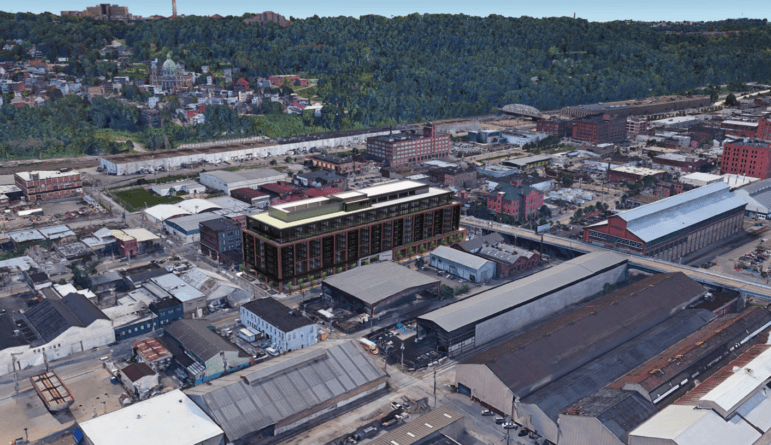
A rendering of the overhead view of the proposed Crucible Lofts building, which developer Westrise Capital wants to build in the Strip District, which was the subject of a City Planning Commission hearing on July 27, 2021.
“It’s not a bad looking building,” said O’Neill. “But I’m missing the piece where it relates to this particular part of the Strip District.”
“We’ve done our best,” responded Lampl. “I don’t know what you want. You want to redesign it?”
He said of O’Neill’s comment that “it sounds like you just don’t want high rises there,” before clarifying that Westrise’s proposal isn’t a high rise.
“Saying, ‘Tough luck, Chuck,’ isn’t an answer,” said O’Neill.
Lampl then characterized the warehouse-type buildings that now occupy most of the site as “reasonably dilapidated … I think the city’s policy is to encourage residential [development] in these high density areas, particularly at or near Downtown.”
The site is bounded by Smallman Street, 31st Street, 32nd Street and Mulberry Way.
Commission Chair Christine Mondor said the city lacks a long-term plan for the Strip, which makes it hard for her panel to weigh the merit of proposals like Crucible Lofts. As the Strip becomes more residential in nature, the city might consider requiring open spaces and park areas, she said.
“I don’t think that [Westrise] bears the responsibility of that,” Mondor said. “I think that they’re playing by the rules,” adding that the city doesn’t have “the right set of rules in place” for that neighborhood.
O’Neill abstained from the subsequent vote, but the other commissioners in attendance approved the plan for Crucible Lofts, clearing the way for construction.
The commission also approved the impending construction by the Regional Industrial Development Corp. of a 96,000-square-foot office building below the skeleton of the Mill 19 structure on the Hazelwood Green brownfield. It will be the third and final structure built beneath the bones of a former steel mill building that is now topped by a solar array.
The building could be complete by November 2022, and no tenant has yet signed on, RIDC consultant Donald Johnson told the commission.
7/22/21: Pittsburgh’s Housing Authority votes for improved apartments, voucher services
The Housing Authority of the City of Pittsburgh plans to help to finance new apartments in East Liberty and will work with the Allegheny County Department of Human Services to furnish vulnerable households with emergency vouchers.
The authority’s board voted to lend $1.8 million to nonprofit ACTION-Housing Inc. as part of financing for its plan to rehabilitate a building at the corner of Highland Avenue and Stanton Avenue. ACTION intends to offer 23 apartments – four with two bedrooms, the rest with one bedroom – to low-income families, if the U.S. Department of Housing and Urban Development [HUD] approves the plan.
Authority staff also told the board that HUD awarded Pittsburgh 142 emergency housing vouchers, which allow holders to pay 30% of their incomes in rent, with the federal government paying the balance to the landlord. The award is part of a nationwide program in which 70,000 such vouchers have been awarded to 626 housing authorities.
The authority will work with the Allegheny County Department of Human Services [ACDHS] to identify households that are homeless, at risk of homelessness, or contending with domestic violence, stalking, human trafficking or similar situations. Those households will get both vouchers and services aimed at helping them to find and retain housing, coordinated by ACDHS. The authority will pay the county department $3,500 for each household served, for a total of $497,000.
7/21/21: Judge rules that Pittsburgh didn’t justify proposed rental inspection fee
The City of Pittsburgh’s 13-year bid to register and regularly inspect rental housing suffered a significant setback today when a judge ruled that its proposed fees were too high and therefore unconstitutional.
The city has been trying, since 2008, to impose registration and inspections on its rental housing market, which now shelters some 55% of its population in nearly 79,000 units. The latest rental registration proposal, passed by Pittsburgh City Council in 2015, called for fees ranging from $45 to $65 per unit, depending on the number of units in a given building. Fees were to drop after three years. Affordable housing was exempt.
The Landlord Service Bureau, Realtors Association of Metropolitan Pittsburgh and Apartment Association of Metropolitan Pittsburgh took the city to court. While the city prevailed on its right to charge a fee, Allegheny County Court of Common Pleas Judge Joseph James held a February trial on the fee. Under Pennsylvania law, a fee is supposed to reflect the cost of a program’s implementation.
At trial, an expert hired by the city said the fee reflected the cost of implementation. An expert hired by the plaintiffs countered that the registration and inspection process would cost the city closer to $13 per unit.
This week Judge James found the plaintiffs’ expert more credible.
“The Ordinance’s charges were an impermissible tax,” he ruled, and the $45-to-$65 charges would “produce a high proportion of income relative to the costs of collection and supervision.”
Mayor Bill Peduto’s administration is “deeply disappointed in the ruling,” according to a spokeswoman, and is “carefully reviewing the decision and considering all options to advance this program which is essential for our neighborhoods.”
7/13/21: Commission chair says plan for block-sized residential building reflects threat to Strip’s character
A proposal by developer Westrise Capital to build an eight-story, 243-unit residential building near the south end of the 31st Street Bridge isn’t out of step with the direction the Strip District has been taking for several years.
It did, however, make City Planning Commission Chair Christine Mondor wonder whether the iconic warehouse and retail district will be recognizable in the future.
Westrise wants to build the Crucible Lofts on the block bounded by Smallman Street, 31st Street, 32nd Street and Mulberry Way, the developer’s representatives told the commission in an initial briefing. The block is currently made up of several industrial or warehouse buildings.
Covering the full block except for a small plaza along 32nd Street, Crucible Lofts would use masonry, glass, steel and potentially a gantry crane to meld the Strip’s industrial aesthetic with a modern residential feel, said Karl Smeltzer of the design firm Gensler.
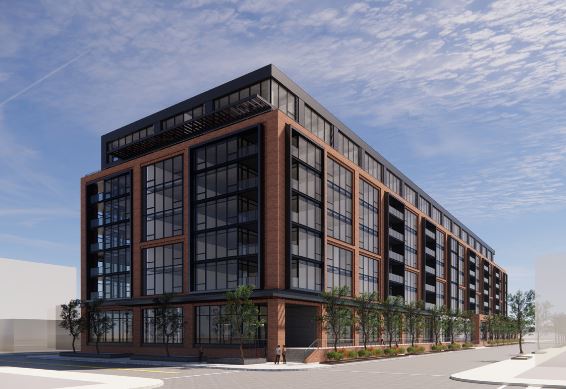
A rendering of the proposed Crucible Lofts building, which developer Westrise Capital wants to build in the Strip District, presented to the City Planning Commission on July 13, 2021.
The commission could hold a hearing and vote on whether to approve it on June 27, and at its initial briefing, members had no specific objections. Mondor admired “the simplicity of the facade” and the evocation of the Strip’s warehouse context, she said.
She noted, though, that the city doesn’t seem to have tools to address the changes the Strip is experiencing.
“We have multiple small parcels being consolidated and built upon in a big project type,” Mondor said. “As we get more and more of these projects that are maximizing their [allowable size] and their density, the character and granularity of the Strip District that we know and love, the ability to have multiple building types, to have activity out on the street and to have mixed use, begins to get scrubbed from the neighborhood.”
She called the Crucible Lofts plan “a very long building, which isn’t out of character with some of the large warehouses that are there.” But she added that the city should think about its stance toward the consolidation of multiple Strip lots and buildings into larger wholes.
“How do we, as a planning commission, as a city, have the tools to think about the Strip District and account for open space, and account for walkable streets, and account for a kind of granularity that isn’t block by block, so that when we look at the neighborhood 20 years from now, we don’t say, ‘Boy, this used to be the Strip, but I’m not sure what it is now?’” she asked.
The city is in the midst of a comprehensive plan called Forging PGH, meant to guide development in all 90 neighborhoods, which the City Planning Department has hoped to complete this year.
7/13/21: CMU seeks to demolish part, keep part of gym building
Carnegie Mellon University’s Skibo Hall was designed by renowned early 20th Century architect Henry Hornbostel. In the 21st Century, though, the hall doesn’t quite work, according to participants in a briefing to the City Planning Commission on a proposal to partially demolish and redevelop it.
“We’ve wrestled with this for a long time,” said Bob Reppe, CMU’s senior director of planning and design. The university prefers not to demolish, “especially a Hornbostle building,” he said, “but it’s really not a functional building.” It lacks elevators and air conditioning, and its roof is not all at one level, making redevelopment difficult, he said.
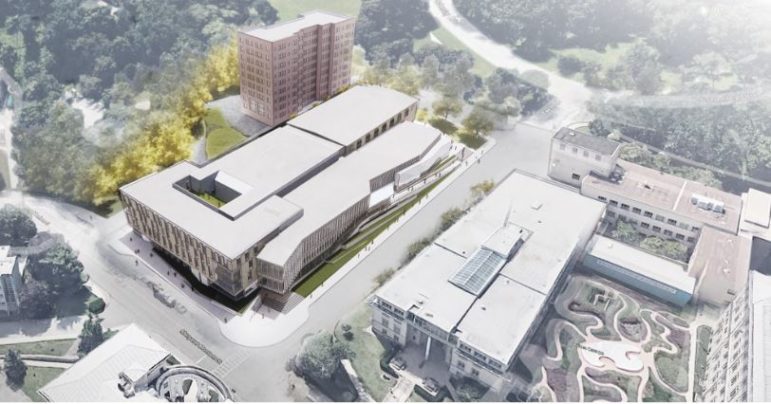
Carnegie Mellon University wants to convert Skibo Hall into a new health, wellness and athletics building, depicted here in a rendering presented to the City Planning Commission on July 13, 2021.
CMU wants to preserve the existing gymnasium, but convert it into a combination track and turf surface for multi-sport training. The rest of the building would be demolished and rebuilt into a new gym, plus activity and office space that would bring together the university’s health, wellness, counseling, psychiatric and athletic offices and functions. A single roof matching the current gymnasium’s height would cover the 160,000-square-foot center.
The commission could vote on CMU’s plan for the hall on July 27.
7/13/21: Commission reviews first step in ‘25- or 30-step process’ for Central Oakland plot
Twelve dilapidated row houses along Bates Street and Coltart Avenue could be demolished if the City Planning Commission approves.
What would replace them? Details weren’t forthcoming at the commission’s initial briefing on the proposed demolition.
Developer Walnut Capital is expected to buy the graffiti-strewn row houses, visible from the Boulevard of the Allies, raze them and transfer the land to the University of Pittsburgh.
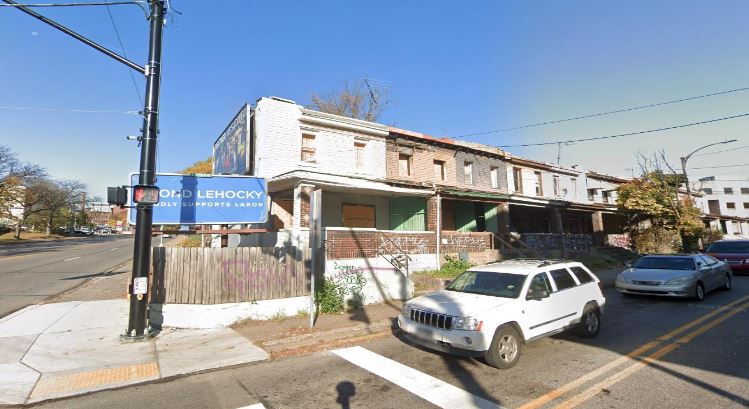
Some of the row houses along Bates Street, in a photo presented to the City Planning Commission by representatives of developer Walnut Capital on July 13, 2021.
“This has been a top priority for Oakland in the past several years to get these properties demolished,” said Jonathan Kamin, one of Walnut Capital’s attorneys, in the briefing. “Some of them do not even have floors in them. You open the door and fall right into the basement.”
Asked by commissioners whether the university plans to build on the site, Kamin said that would depend on the results of a holistic look at that section of Oakland. “Pitt will eventually be buying this, but this is step one of probably a 25- or 30-step process,” he said, in which there are “a lot of pieces at play.”
The commission is expected to hear public testimony and vote July 27.
7/13/21: Hazelwood Green’s Mill 19 may be headed toward completion
The first redeveloped section of the mammoth 178-acre Hazelwood Green site could get a new 96,000-square-foot office and lab building, per a presentation made to the City Planning Commission.
The Mill 19 portion of the site is named for the skeletal relic of a steelmaking building that spans it and holds a vast solar array. To date, two-thirds of the area under that skeleton has been redeveloped. Though it does not yet have a tenant lined up, the nonprofit Regional Industrial Development Corp. wants to fill the rest with office, lab and research space. RIDC owns the Mill 19 part of Hazelwood Green.

A rendering of the Mill 19 complex, on the Hazelwood Green site, as it would look after completion of the development beneath its vast solar array, presented to the City Planning Commission on July 13, 2021.
As much as half of the new building’s power will be provided by the solar arrays, according to RIDC’s presentation.
The City Planning Commission is expected to vote on July 27 on the proposal.
7/1/2021: Eviction hotspots include eastern suburbs, Mon Valley, Pittsburgh’s Hilltop
Eviction filings in Allegheny County rose in June, following two months of relatively low case counts.
Landlords filed 469 cases against tenants in June. That’s less than half of a typical pre-pandemic month but the highest total since October.
Since mid-March 2020, a series of federal, state and local actions driven by the COVID-19 pandemic have restricted eviction filings. Rent relief programs for tenants whose livelihoods have been affected by the pandemic have also helped some renters to stay current or pay overdue balances.
The Centers for Disease Control and Prevention (CDC) order in place since September was recently extended through the end of July. But the CDC has indicated that it does not anticipate a further extension.
During the first quarter of 2021, Baldwin, McKeesport and Penn Hills were hotspots for eviction filings.
During the second quarter, the largest concentrations of filings by landlords were in and around Wilkinsburg, Monroeville, Pittsburgh’s Hilltop neighborhoods, Braddock and Duquesne, McKees Rocks and Stowe, and North Versailles.
— Nick Tommarello contributed.
June recap:
News from the City Planning Commission, Urban Redevelopment Authority, Housing Authority of the City of Pittsburgh and more
Soaring rents, waning options: For tenants on tight budgets, the North Hills isn’t a friendly place
Inclusionary zoning is taking hold in Lawrenceville. Is the rest of Pittsburgh next?
Can East Hills residents reverse ‘blightlining’ and ‘rotrification’ on Park Hill Drive?
Develop PGH archives
Some Pittsburgh environmental groups are trying to undo a legacy of neglect by prioritizing projects in underserved communities
Why is UPMC spending millions on affordable housing? It’s less about the mayor than about health and investments
Renters: Here is how to find legal help, mental health support and shelter in Allegheny County
Pittsburgh’s oldest Black church was demolished as ‘blight’ in the 1950s Lower Hill. Today, members seek justice.
Tenant Cities: Portraits of households facing displacement in the pandemic
May development coverage
Rich Lord is PublicSource’s economic development reporter. He can be reached at [email protected] or on Twitter @richelord.
Develop PGH has been made possible with funding from The Heinz Endowments.
